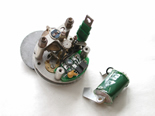The tach-mounted Smiths clock has been used on Jaguars from the mid 30's to the mid 60's. The electrical contact is the weak link in these clocks, so they never seem to run long enough for anything else to wear out. Actually, it's not surprising that the contacts fail, when you consider what they are required to do. Normally, the current for the coil passes directly through the contacts, which close and open five times per second. Each of these cycles causes a spark, which is easily visible. At the rate of 5 per second, this spark occurs 18,000 times per hour, 432,000 times a day, and 157,680,000 times per year! It's no wonder they fail so quickly.
Our upgrade uses the contacts as a trigger for an integrated circuit (IC), which actually provides the power pulse to the coil. The contacts are required to pass much less current than they normally handle. In addition, the circuit produces a constant width electrical pulse to the coil, which gives the balance wheel a solid kick, no matter how bouncy or dirty the contacts are. The same idea is used in dwell-extender electronic ignitions. We use a custom printed circuit board that uses surface mount techniques to shrink the circuit down to the size where it will fit inside the clock. None of the original clock parts are removed, so the installation is totally reversible, in case you ever want a non-functional clock again!

We use a state-of-the-art electronic calibrator to adjust your clock.
The calibrator is a microcontroller-based device which counts the number of ten-millionths of a second in a single tick. To fine-tune the adjustment, the calibrator also keeps a running total of 10, 100, 1000, 10,000 and 100,000 ticks. This provides an average over time, integrating variations in individual ticks, which allows us to adjust it so it will perform accurately when installed in your
car. However, since the clock still uses a balance-wheel, it will never be as accurate as a crystal controlled digital wristwatch. But if we wanted modern technology we wouldn't be driving classic cars!